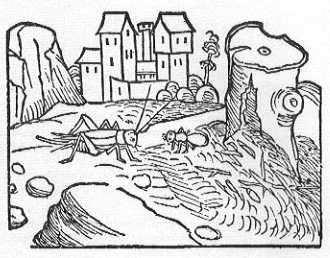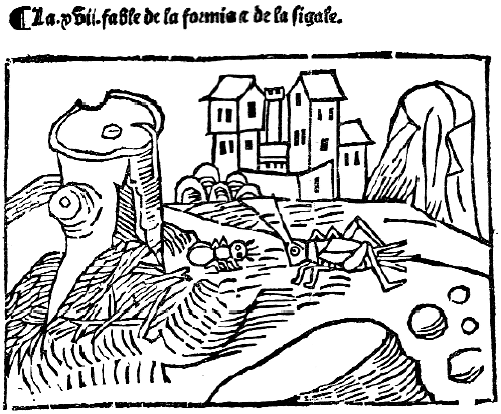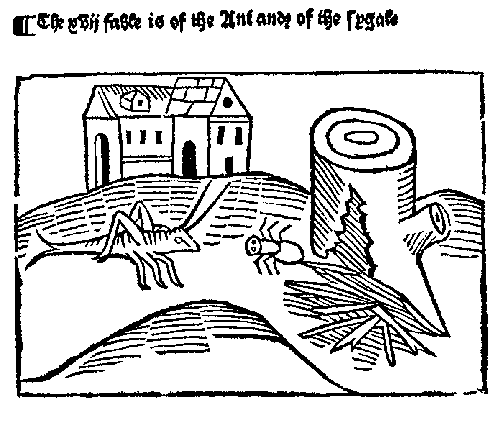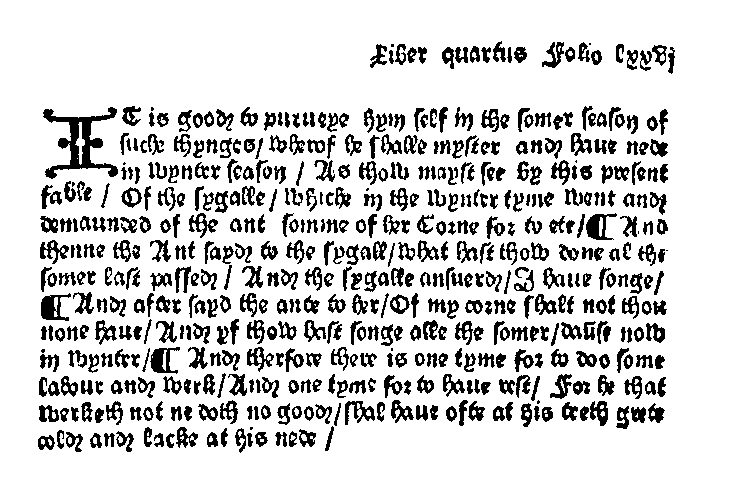インターネットで蝉を追う第5章
|
15世紀の半ば、グーテンベルクの活字印刷術の発明は、まことに革命というにふさわしい影響を及ぼした。しかし、彼の初志は、いかにして美しい写本を再現するかにあったということを忘れてはならない。ここに、いわゆる「初期印刷本(incunabula)」と呼ばれる独特の製本を生み出すこととなった。
この初期印刷本の普及に大いに寄与したのが、(聖書と並んで)イソップ寓話集であったといってよい。「シュタインヘーヴェルがドイツ語に訳したイソップ寓話集が100以上の異本に印刷されたのは、驚嘆せざるをえない」(プレッサー『書物の本』p.66)。
ハインリヒ・シュタインヘーヴェルが、ラテン語イソップ寓話を集成し、ラテン語・ドイツ語対訳本として出版したのは、1476/77年ころウルムにおいて(印刷者はヨハン・ツァイナー)であった。おそらく好評ゆえ、今度はアウグスブルクで、ヨハンの親類ギュンター・ツァイナー(1478年)が再版し、さらにはアントン・ゾルクがこれに続く(1479&1480年)。
他方、フランスにおいては、シュタインヘーヴェルの対訳本をもとに、ジュリアン・マショーがフランス語訳し(1483年)、その翌年(1484年)には、イギリスにおいてキャクストンが、仏訳本からの重訳を出版した。
この流れの中で、「蟻と蝉は」どのように訳されていったであろうか。
[参考1]1479年ころのアウグスブルク版(ゾルク印刷本)の挿し絵

Aesop five centuries of illustrated Fables / selected by John J. McKendry(The Metropolitan Museum of Art, 1964) p.15 による。
German woodcuts from Aesop's life and fables, Anton Sorg, Augsburg, about1479 [first edition Johann Zainer, Ulm, about 1476-77]. Dick Fund, 37.39.6. (p.92)
【ラテン語本文】
Steinhowel. Book 4. Fable 17. Fabula xvii de formica et cicada.
Hyemis tempore formica frumentum trahens ex caverna siccabat quod estate colligens coagulaverat. Cicada autem esuriens rogabat eam, ut daret aliquid illi de cibo, ut viveret. Cui formica: quid fecisti, inquit, in estate? At illa: Non mihi vacavit, per sepes oberravi cantando. Ridens formica ac frumentum includens dixit: Si estate cantasti, hyeme salta.
Hec fabula pigrum docet, ut tempore certo laboret, ne, dum minus habuerit et petierit, non accipiat.
【ドイツ語訳】〔[]はウムラウト付き。改行は引用者による〕
[144b] Die xvii fabel von der amais und dem grillen.
Ze winter zyt zoch ain amais ir koren, das sie den summer hett yngetragen und zesamen behalten, uss dem hol an den luft ze tr[u]knen.Do kam ain hungriger grill zuo ir und bat sie umb die spys, daz sie lebebd belyben m[o]chte.
Do sprach die amais zuo im: Was hast du den summer getaun?
Antw[u]rt der grill: Ich bin nit m[u]ssig gegangen. Ich bin hin und her durch die zyn gesprungen und hab gesungen.
Do lachet die amais, beschloss ir korn und sprach: Hast du dann den summer gesungen, so spring den winter.
Dise fabel leret die tr[a]gen, die nit gern arbeiten, daz sie zuo rechten zyten arbaiten s[o]llent, ob sie villycht ettwan gebruch haben wurdent, daz nieman w[a]re, der inen ze hilff k[a]me.
----------------------------------------------------------------
Oesterley, Hermann (ed.). Steinhowels Asop. Tubingen: L. F. Fues, 1873.
[参考2]マシュー版の挿し絵と本文

La.xvii. fable de la formis & de la sigale.
Il fait bon amasser en l'este pour vivre en l'iver, comme il appert par
ceste fable d'une sigale qui ala demander au temps d'iver a la formis de
son ble pour menger. Et adonc la formis luy dist: Que as tu fait au temps
de l'este passe? Et la sigale luy dist: J'ay chante. Et puis la formis luy
dist: De mon fortment n'auras tu point, et si tu as chante tout l'este,
dance maintenant en l'iver. Et pour tant il y a temps de labourer et temps
de reposer, car celuy qui ne labeure aura grant froit aux dens.
<transliterated by TAKEMULA Hiloshi>
キャクストン版
(THE HISTORY AND FABLES OF AESOP
Translated and printed by William Caxton
at Westminster 1484)
Book IV
Folio 76, 左頁 の挿し絵

Folio 76, 左頁 の本文

Liber quartus Folio lxxvi
The xvii fable is of the Ant and of the Sygale
IT is good to purueye hym self in the somer season of
suche thynges / wherof he shalle myster and haue nede
in wynter season / As thow mayst see by this present
fable / Of the sygalle / which in the wynter tyme went and
demaunded of the ant somme of her Corne for to ete / And
thenne the Ant sayd to the sygall / what hast thow done at the
somer last passed / And the sygalle ansuerd / I haue songe /
And after sayd the ante to her / Of my corne shalt not thou
none haue / And yf thow hast songe alle the somer / danse now
in Wynter / And therfore there is one tyme for to doo some
labour and werk / And one tyme for to haue rest / For he that
werketh not ne doth no good / shal haue ofte at his teeth grete
cold and lacke at his nede /
<transliterated by TAKEMULA Hiloshi>
シュタインヘーヴェル版の"Grille"、マショー版の"sigale"、キャクストン版の"sygalle"の語に注目!!
"Grasshopper"はいまだ登場しないのである。しかし、版画はまぎれもなく、バッタ類を表している。これをどう考えればよいのであろうか?
 Barbaroi!
Barbaroi!